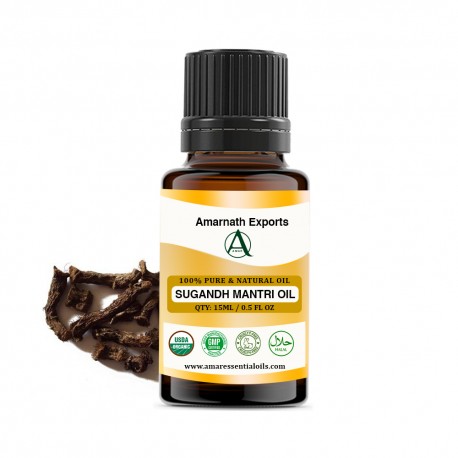No products
Product successfully added to your shopping cart
There are 0 items in your cart. There is 1 item in your cart.
Sugandh Mantri Oil (Gandhi Root)
New
Sugandh Mantri is a fragrant perennial herb native to Assam, as well as the lower altitudes of Arunachal, Nagaland, and Tripura in India. It boasts a short stem and a slow growth rate. The leaves are characterized by their radical arrangement, sheathing bases, long petioles, and sagittate-cordate shape.
573 Items
More info
- Botanical Name: Homalomena aromatica
- Family Name: Araceae
- Common Name: Gandhi Roots, fragrant swamp, pavonia and fragrant pavonia.
- Part used: Crushed roots
- Method of Extraction: Steam Distillation
- Origin: India
- Appearance: Light Yellowish to Pale Yellow Liquid
- Odor: Refreshing Pleasant Spicy & Typical Characteristic note of linalool
- Odour Strength: Strong
- Industrial Use: Fragrance Industry, Flavour Industry, Pharmaceutical Indus try, Food Industry, Cosmetic Industry , Incense Industry
- Blends well with: Bergamot, Clary Sage, Cypress, Fennel, Ginger, coriander oil, Grapefruit,Jasmine,Lavender,Neroli,Patchouli,Rose Otto.
Buy Sugandh Mantri Oil | Homalomena aromatica
These plants are predominantly found in swamps, primarily in India. They feature heart-shaped leaves and spherical fruits. Thriving in moisture and shade, they are best cultivated under 40-60% shade. Being a sub-tropical species, they flourish in warm, humid climates with annual rainfall ranging from 2000-3000 mm. Plant height typically ranges from 0.45-0.75 m, slightly taller in shaded areas. The optimal time for planting is from April to June, coinciding with pre-monsoon showers to the onset of the monsoon. The recommended planting method is the ridge and furrow technique.
What is Sugandh Mantri?
Sugandh Mantri oil, also known as Gandhi Root or Wild Sugandh Mantri, is an aromatic essential oil renowned for its therapeutic properties and delightful fragrance. Derived from the roots of the Gandh Prasarini plant, this oil has been cherished for centuries for its diverse benefits, ranging from aromatherapy to skincare.
The history of Sugandh Mantri oil traces back to ancient Ayurvedic texts, where it was revered for its medicinal properties. The Gandh Prasarini plant, scientifically known as Homalomena aromatica, is native to the Himalayan regions of India and Nepal. Its roots are steam distilled to extract the precious oil, which is then used in various traditional remedies and aromatherapy practices.
Properties of Sugandh Mantri Oil
Sugandh Mantri oil derives its aromatic and therapeutic qualities from its complex chemical composition. It contains various compounds such as methyl eugenol, eugenol, linalool, and terpinen-4-ol, among others. These constituents contribute to its sweet, floral scent and therapeutic effects, including anti-inflammatory, antispasmodic, and antimicrobial properties.
Uses and Benefits of Sugandh Mantri Oil
Aromatherapy
Sugandh Mantri oil is a popular choice in aromatherapy due to its uplifting aroma and stress-relieving properties. Inhalation of its vapors through diffusers or steam inhalation can promote relaxation, improve mood, and alleviate symptoms of anxiety and depression.
Perfumery
The captivating scent of Sugandh Mantri oil makes it a prized ingredient in perfumery and fragrance industry. It is often used as a base note in perfumes, adding depth and complexity to floral and oriental fragrances.
Medicinal Uses
In Ayurvedic medicine, Sugandh Mantri oil is valued for its therapeutic effects on the mind and body. It is believed to have analgesic properties, making it beneficial for relieving headaches, muscle pain, and menstrual cramps. Additionally, it is used in skincare formulations for its antibacterial and anti-inflammatory properties, aiding in the treatment of acne and skin infections.
Reviews
No customer comments for the moment.








